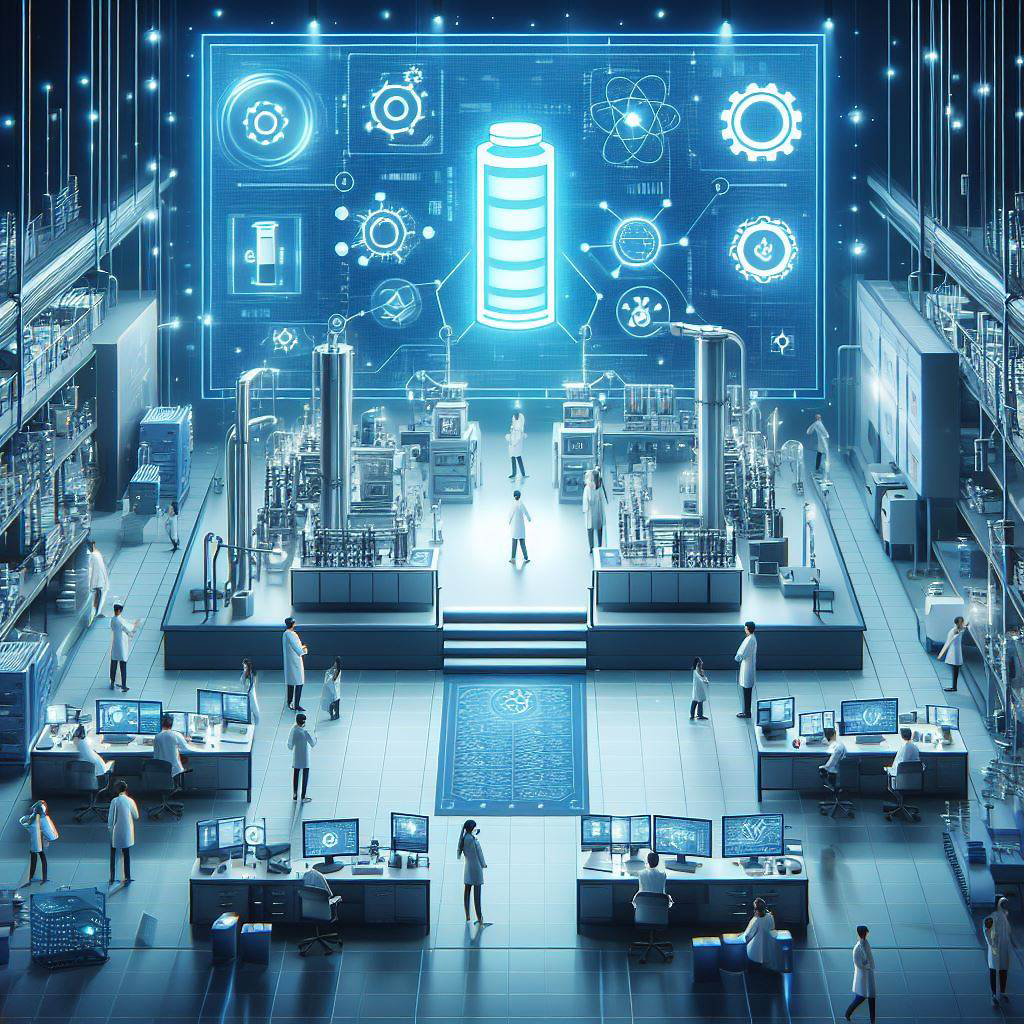Digitalization Drives Innovation: Exploring the Digital Transformation of New Energy Battery Manufacturing Enterprise Laboratories
Released:2024-01-05
With the rapid development of science and technology, digital transformation has become an important driving force for innovation and development in all walks of life. As an important pillar of green energy in today's world, the new energy battery manufacturing industry is facing unprecedented opportunities and challenges. The practice and application of digital transformation in new energy battery manufacturing enterprises is of great significance to enhance the core competitiveness of enterprises and promote the sustainable development of the industry.
In the laboratory of new energy battery manufacturing enterprises, digital transformation is not only the embodiment of technological progress, but also the key to improving R&D efficiency and product quality. Through digital technology, the laboratory can realize real-time collection, processing, analysis and mining of experimental data, and provide accurate data support for R&D personnel. At the same time, digital transformation can help optimize production and R&D processes, improve equipment utilization and experimental efficiency, and reduce energy consumption and labor costs.

Core elements of digital transformation
1. Data collection and processing:In the laboratory of new energy battery manufacturing enterprises, data collection and processing are the foundation of digital transformation. Through advanced sensors and intelligent equipment, real-time collection of experimental data, through efficient processing, improve the accuracy and real-time of data, and provide strong support for subsequent R&D and production. For example, a high-precision data acquisition system is used to monitor and record various parameters in the battery manufacturing process in real time to ensure the stability of product quality and performance.
2. Data analysis and mining:Use big data and artificial intelligence technology to conduct in-depth analysis and mining of experimental data, reveal the laws and knowledge behind the data, provide accurate data support for R&D personnel, and help optimize product performance and improve production processes. Through data analysis, companies can better understand battery performance, optimize material formulations, and improve production processes, thereby improving product quality and reducing costs.
3. Industrial Internet of Things:Through the industrial Internet of Things technology, the interconnection and intelligent control of laboratory equipment are realized. Through remote monitoring, real-time feedback and automatic control, the experimental efficiency and equipment utilization rate are improved, and the energy consumption and labor costs are reduced. For example, the Internet of Things technology is used to realize remote control and monitoring of laboratory equipment to improve the accuracy and repeatability of experiments, and at the same time monitor the operation status of equipment in real time and fault warning, reducing equipment maintenance costs and downtime.
4. Cloud computing and edge computing:With the help of cloud computing and edge computing technology, it provides powerful computing power and data processing power. The experimental data is stored in the cloud for easy access and analysis anytime, anywhere, and the edge computing is used for real-time data processing and feedback to improve the accuracy and response speed of experiments, and the cloud computing resources are used to conduct large-scale parallel computing and simulation experiments to accelerate battery performance research and product development.
Challenges and solutions in the process of digital transformation
1. Data security and privacy protection:In the process of digital transformation, data security and privacy protection are important challenges faced by enterprises. Ensure data security and compliance, adopt effective encryption technology and access control measures, and protect enterprise core information and intellectual property. For example, strengthen data encryption and access control mechanisms to prevent data leakage and unauthorized access, and establish sound data management systems and processes to ensure data compliance and traceability.
2. Technology update and talent training:Continuously investing in and developing a workforce that is proficient in new technologies is the key to achieving digital transformation. Through training and practice, we can improve the technical level and innovative thinking of employees, and promote enterprises to stay ahead of the digital transformation process. For example, we regularly organize technical training and exchange activities to improve the technical level and innovation ability of employees, and actively introduce outstanding talents to strengthen team building and cooperation atmosphere.
3. Organizational change and management innovation:Digital transformation requires organizational change and management innovation. Build an organizational structure and process system that adapts to digital transformation, break the traditional mindset, encourage innovation and collaboration, and inject vitality into the sustainable development of the enterprise. For example, establish an organizational structure and process system that adapts to digital transformation, break down departmental barriers and information silos, and encourage employees to actively participate in innovation activities and technology research to improve the company's innovation ability and market competitiveness.
The LIMS system helps digital construction
1. Centralized management of experimental data:As a key tool for digital transformation, the LIMS system realizes the centralized management of experimental data. Establish a unified data storage platform to facilitate laboratory personnel to quickly access and share experimental data. By centrally managing experimental data, data silos are eliminated and data consistency and accuracy are improved. At the same time, the risk of data loss is reduced and data security is improved.
2. Process Automation:With a LIMS system, laboratories are able to automate their experimental processes. From sample management to experiment report generation, the LIMS system improves laboratory productivity, reduces human error, and ensures consistency and traceability of experiments. Automating the process also reduces the reliance on manual operation and improves the accuracy of the experimental process.
3. Quality control and complianceThe LIMS system supports the establishment of quality control processes and monitors the compliance of laboratory work. Ensure that laboratory work meets the requirements of industry regulations and standards by setting standardized experimental procedures and specifications. The quality control function of the LIMS system also provides real-time monitoring and early warning of the experimental process to ensure the reliability and accuracy of the experimental results.
4. Intelligent report generationThe LIMS system has the function of intelligent report generation, which automatically generates reports based on experimental data, which not only improves the accuracy of the report, but also saves the time of laboratory personnel, enables decision-makers to obtain experimental results in a more timely manner, and supports data visualization and analysis, which helps to understand the experimental results more intuitively and supports the decision-making process.
5. Guarantee of data security
The LIMS system ensures the security of laboratory data through strong data encryption technology and strict permission control. The system's backup and recovery capabilities further enhance data integrity and reliability. At the same time, the LIMS system provides access control and auditing capabilities for experimental data, ensuring that only authorized personnel can access and modify the data. This greatly reduces the risk of data leakage and misuse, protecting the core information and intellectual property of the enterprise.
The digital transformation of the laboratory of a new energy battery manufacturing enterprise is a continuous process that requires continuous investment and improvement. Enterprises should keep an eye on new technologies and methods, and update and upgrade their LIMS systems in a timely manner to adapt to changing market needs and technological developments. Through continuous digital transformation, new energy battery manufacturers will be able to better respond to industry challenges, enhance their competitiveness and innovation capabilities, and make greater contributions to sustainable development.
Related
Construction of digital laboratories for environmental testing institutions: with the help of science and technology, we will create a green future
Today, with the rapid development of science and technology, digital laboratories have become the core strength of environmental protection testing institutions. It not only improves the efficiency and accuracy of detection, but also provides more accurate data support for environmental protection.
Digitalization Drives Innovation: Exploring the Digital Transformation of New Energy Battery Manufacturing Enterprise Laboratories
With the rapid development of science and technology, digital transformation has become an important driving force for innovation and development in all walks of life. As an important pillar of green energy in today's world, the new energy battery manufacturing industry is facing unprecedented opportunities and challenges. The practice and application of digital transformation in new energy battery manufacturing enterprises is of great significance to enhance the core competitiveness of enterprises and promote the sustainable development of the industry.
Policy interpretation of the "Guiding Opinions on Promoting the Improvement of Enterprises' Measurement Capabilities".
In recent years, various competent authorities have issued many policies to encourage enterprises to improve their measurement management capabilities, such as the State Administration for Market Regulation and the Ministry of Industry and Information Technology jointly issued the "Guiding Opinions on Promoting the Improvement of Enterprises' Measurement Capabilities". The document proposes a number of measures, including strengthening the accumulation and application of enterprise measurement data, and building an enterprise measurement technology innovation ecology. Under the guidance of this important document, the company will usher in a clearer development direction in strengthening the construction of the measurement management system. This article will interpret the key provisions of the Guiding Opinions on the basis of them in combination with the policy guidance emphasized therein.
Pain points and LIMS solutions for rail transit testing institutions
With the advancement of science and technology and the implementation of digital policies, the rail transit industry is facing unprecedented challenges and opportunities. Especially in the field of equipment measurement management, the traditional model can no longer meet the needs of modern enterprises. In response to this trend, more and more rail transit companies are looking for innovative solutions. This paper will discuss the application of digital solutions in the management of metrology equipment in rail transit enterprises, and focus on the value and implementation of laboratory information management system (LIMS).
How to realize the integration of business and laboratory informatization of third-party testing laboratories
With the advancement of science and technology and the continuous development of global trade, third-party testing laboratories play an increasingly important role in ensuring product quality and safeguarding consumer rights. In this context, how to realize the integration of business and laboratory informatization and further improve the efficiency and accuracy of testing has become a problem worth exploring.
How to choose a laboratory management system (LIMS) for food processing enterprises
With the rapid development of the food processing industry, the demand for laboratory management systems is also increasing. Laboratory management systems (LIMS) are an indispensable part of food processing companies as they can effectively improve the efficiency and accuracy of laboratories and reduce costs. However, how to choose the right LIMS system for your business?










